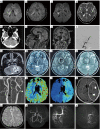Advances in differential diagnosis of cerebrovascular diseases in magnetic resonance imaging: a narrative review
- PMID: 37064346
- PMCID: PMC10102759
- DOI: 10.21037/qims-22-750
Advances in differential diagnosis of cerebrovascular diseases in magnetic resonance imaging: a narrative review
Abstract
Background and objective: Cerebrovascular diseases (CVDs), particularly cerebral stroke, remain a primary cause of disability and death worldwide. Accurate diagnosis of CVDs is essential to guide therapeutic decisions and foresee the prognosis. Different CVDs have different pathological processes while they have many signs in common with some other brain diseases. Thus, differential diagnoses of strokes from other primary and secondary CVDs are especially important and challenging.
Methods: This review is composed mainly based on searching PubMed articles between September, 2013 and December 26, 2022 in English.
Key content and findings: Neuroimaging is a powerful tool for CVD diagnosis including cerebral angiography, ultrasound, computed tomography, and positron emission tomography as well as magnetic resonance imaging (MRI). MRI excels other imaging techniques by its features of non-invasive, diverse sequences and high spatiotemporal resolution. It can detect hemodynamic, structural alterations of intracranial arteries and metabolic status of their associated brain regions. In acute stroke, differential diagnosis of ischemic from hemorrhagic stroke and other intracranial vasculopathies is a common application of MRI. By providing information about the pathological characteristics of cerebral diseases exhibiting different degrees of behavioral alterations, cognitive impairment, motor dysfunction and other indications, MRI can differentiate strokes from other primary CVDs involving cerebral small vessels and identify vascular dementia from hyponatremia, brain tumors and other secondary or non-primary CVDs.
Conclusions: Recent advances in MRI technology allow clinical neuroimaging to provide unique reference for differentiating many previously inconclusive CVDs. MRI technology is worthy of full exploration while breaking its limitations in clinical applications should be considered.
Keywords: Cerebrovascular diseases (CVDs); cerebral stroke; differential diagnosis; magnetic resonance imaging (MRI); neuroimaging.
2023 Quantitative Imaging in Medicine and Surgery. All rights reserved.
Conflict of interest statement
Conflicts of Interest: All authors have completed the ICMJE uniform disclosure form (available at https://qims.amegroups.com/article/view/10.21037/qims-22-750/coif). The authors have no conflicts of interest to declare.
Figures




Similar articles
-
Vessel Wall Magnetic Resonance Imaging in Cerebrovascular Diseases.Diagnostics (Basel). 2022 Jan 20;12(2):258. doi: 10.3390/diagnostics12020258. Diagnostics (Basel). 2022. PMID: 35204348 Free PMC article. Review.
-
Neuroimaging in cerebrovascular disorders: measurement of cerebral physiology after stroke and assessment of stroke recovery.Semin Nucl Med. 2003 Jan;33(1):56-76. doi: 10.1053/snuc.2003.127293. Semin Nucl Med. 2003. PMID: 12605357 Review.
-
Trial design and reporting standards for intra-arterial cerebral thrombolysis for acute ischemic stroke.Stroke. 2003 Aug;34(8):e109-37. doi: 10.1161/01.STR.0000082721.62796.09. Epub 2003 Jul 17. Stroke. 2003. PMID: 12869717
-
Magnetic resonance imaging (MRI) for the assessment of myocardial viability: an evidence-based analysis.Ont Health Technol Assess Ser. 2010;10(15):1-45. Epub 2010 Jul 1. Ont Health Technol Assess Ser. 2010. PMID: 23074392 Free PMC article.
-
Hybrid Imaging of Vascular Cognitive Impairment.Semin Nucl Med. 2021 May;51(3):286-295. doi: 10.1053/j.semnuclmed.2020.12.006. Epub 2020 Dec 20. Semin Nucl Med. 2021. PMID: 33353723 Review.
Cited by
-
Diagnostic model for distinguishing fresh or old osteoporotic vertebral compression fractures based on modified computed tomography window: a retrospective cohort study.Eur Spine J. 2025 May 21. doi: 10.1007/s00586-025-08923-9. Online ahead of print. Eur Spine J. 2025. PMID: 40397145
-
Biomedical applications of stimuli-responsive nanomaterials.MedComm (2020). 2024 Jul 20;5(8):e643. doi: 10.1002/mco2.643. eCollection 2024 Aug. MedComm (2020). 2024. PMID: 39036340 Free PMC article. Review.
-
The value of postcontrast delayed 3D fluid-attenuated inversion recovery MRI in the diagnosis of unilateral peripheral vestibular dysfunction.Quant Imaging Med Surg. 2023 Aug 1;13(8):5072-5088. doi: 10.21037/qims-22-1268. Epub 2023 Jun 8. Quant Imaging Med Surg. 2023. PMID: 37581086 Free PMC article.
-
Alcohol Use Disorder and Dementia: A Review.Alcohol Res. 2024 May 23;44(1):03. doi: 10.35946/arcr.v44.1.03. eCollection 2024. Alcohol Res. 2024. PMID: 38812709 Free PMC article. Review.
-
Stratifying vascular disease patients into homogeneous subgroups using machine learning and FLAIR MRI biomarkers.Npj Imaging. 2024;2(1):56. doi: 10.1038/s44303-024-00063-x. Epub 2024 Dec 31. Npj Imaging. 2024. PMID: 39749287 Free PMC article.
References
Publication types
LinkOut - more resources
Full Text Sources
